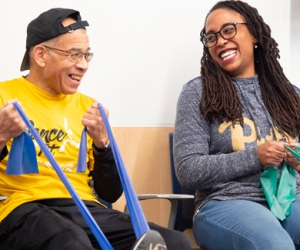
Decoding the Benefits of Exercise at the Molecular Level
New study seeks insights on the benefits of exercise for individuals
Science has proven that exercise is good for human health. But exactly why this is true—a full understanding of the biological processes that produce the health benefits—is not well understood.
And even less understood is knowledge about which forms of exercise are the most beneficial to a specific person.
The conventional wisdom with exercise is that more physical activity is always better. However, health experts say that some people are wired to receive more health benefits from cardio exercise than weight training—and vice versa. What if there was a way to prescribe exercise routines to individuals based on precisely what would be the most beneficial to them?
The National Institutes of Health is embarking on a large-scale research study to shed light on these questions. Seeking to fully understand how physical activity occurs at the molecular level, the Molecular Transducers of Physical Activity program is putting $170 million toward to study the effects of exercise on 2,280 adults in locations nationwide. It is the largest project the NIH has ever undertaken to study the effects of exercise on humans.
In 2017 the University of Pittsburgh was selected as one of 19 research sites nationwide.
The project hit a new milestone this past August when the Pitt team began work on its portion of the study, which will occur through 2022.
The Pitt team is being lead by the Pitt School of Education’s Healthy Lifestyle Institute. Research is being performed by the school’s faculty, staff, and graduate students. The research study is an opportunity to gain real-world experience for the students in Pitt Education’s health, exercise, and physical activity degree programs
“The study seeks to answer two questions. Why is exercise good for you? And how can we move closer to precision health with activity and exercise?” said John Jakicic, a professor, chair of the Department of Health and Physical Activity, and founding director of the Healthy Lifestyle Institute.
Precision Medicine as the Next Frontier of Exercise Science
Jakicic is the principal investigator at Pitt on the project. His team will recruit 380 people for the exercise study to be conducted at the Healthy Lifestyle Institute offices in Oak Hill. The facilities are equipped with state-of-the-art equipment to measure the effects of physical activity. The focus will be on healthy adults, aged between 18 to around 80 years old, who are diverse in gender, race, and ethnicity.
The study will compare people who are classified as sedentary based on their limited physical activity with people who are highly trained in exercise. Participants will be paid between $800 to $2,000 based on the length of their time commitment. The maximum time commitment can range from 3-6 months, which can include 12 weeks of supervised exercise training.
Participants will be divided into separate groups for endurance training (which will consist of both stationary cycling and treadmill walking or jogging) and resistance training through strength-building exercises. Participants will be tested at both their resting state and post-exercise. Samples of blood and tissues will be taken.
“We wish to understand, biologically, how different forms of exercise impact different physiological responses, which includes how cells communicate in different tissues such as muscle and adipose (fat). We know activity is important but don’t fully understand why, and this study will help to get us closer to that answer” said Jakicic.
Jakicic predicts that the research results will show that small amounts of exercise can make an immediate impact, even for individuals who start off less fit than others. Benefits may include fat loss, muscle building, improvements in cardiovascular fitness and strength, and improvements in more traditional health risk factors such as blood pressure, blood lipids, and others.
“The human body is amazing and is very resilient, which reflects the body’s ability to constantly repair itself and maintain a high level of health and function. This study is about better understanding the resiliency of the human body, which may allow us to be able to detect the cellular changes that are responsible for this resilience,” said Jakicic.
Study Demonstrates “The Power of Pitt”
Ultimately, the research findings may provide definitive answers on why and how exercise affects certain types of people. This will enable people to focus their limited time for exercise on the physical activities that benefit them the most.
Jakicic said the data may also lay the groundwork for the development of medicine to mimic the cell signals from exercise. While there may never be a true “magic pill” for exercise, the medicine could provide some health benefits for people with physical conditions that limit their ability to exercise, such as the elderly or disabled.
All of the research findings will be housed in a public access database that researchers can use for their own independent studies. The results will be published as the studies progress, as opposed to afterward, like in clinical trials.
“We expect this to explode the science to a space we haven’t seen before,” said Jakicic.
Led by the Healthy Lifestyle Institute, the Pitt team represents a true collaborative effort across the university. In addition to Jakicic, other Pitt School of Education faculty involved in the project include Renee J. Rogers, assistant professor of health and physical activity, and Lindsay C. Page, assistant professor of research methodology and research scientist with the Learning Research and Development Center.
Other University of Pittsburgh faculty on the project include Daniel E. Forman, chair of the Section of Geriatric Cardiology within the Department of Medicine; Erin E. Kershaw, chief of the Division of Endocrinology and Metabolism within the Department of Medicine; Anne B. Newman, chair of the Department of Epidemiology within the Graduate School of Public Health; Maja Stefanovic, MD in the Division of Endocrinology and Metabolism within the Department of Medicine; Bradley C. Nindl, director of the Neuromuscular Research Laboratory in the Department of Sports Medicine and Nutrition within the School of Health and Rehabilitation Sciences.
“We had to work across Pitt to make it happen. This shows you the power of Pitt,” said Jakicic.
Additional Information
The Healthy Lifestyle Institute at the Pitt School of Education is recruiting adults in the Pittsburgh area for the Molecular Transducers of Physical Activity Consortium program.
To find out more about the study, visit www.motrpac.org or contact the study at 412-383-4055.




